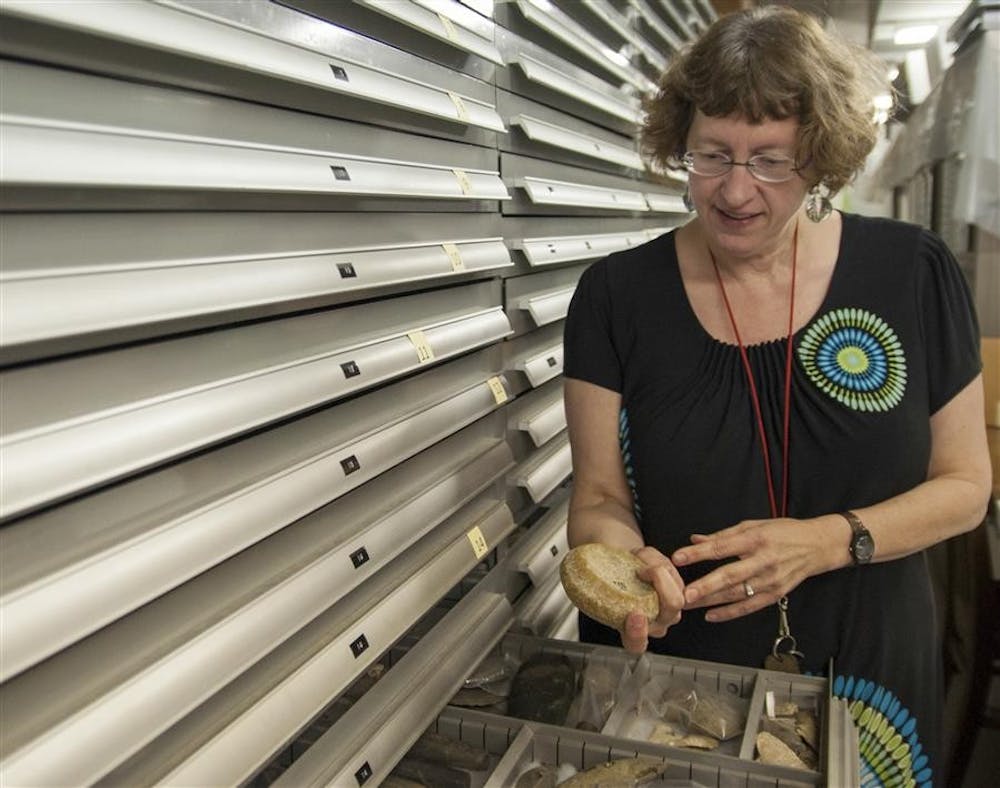On the floor below the Office of the Vice Provost for Research sits a research lab of less than 10 people, only two of whom are full-time employees.
The Glenn Black Laboratory of Archaeology, which was established in 1965, is a 10,000 square-foot research lab that houses multiple collections of archaeological findings.
These findings include a raw material collection, a projectile points type collection and Eli Lilly’s personal collection.
Many of these collections are defined by the location in which they were found and at what time. The collections include stone tools, pots and fragments and shards of raw material such as clay.
However, because space is so limited, the lab staff is having difficulty furthering its research, Director April Sievert said. Sievert and her team of researchers are preparing a formal request to the University for additional funding for expansion.
“I’ve only been in this job for eight months now, but every day I learn something new about the collections and how amazing they are, but also what we need,” Sievert said.
In addition to the lack of space, Sievert said, the facility is having climate control issues. To protect the collections from damage, the temperature and humidity must be controlled and dirt and insects kept out.
“Now as a director, I have to figure out how to go about solving some of those long-term problems,” Sievert said, “It’s a huge responsibility to keep the collections safe and to make them accessible to people and to promote research with them.”
Because of the limited space, Sievert said she and her staff are unable to perform critical rehabilitation on the collections.
Rehabilitation would require the team to take out the collections, re-clean them, and re-package them, which they do not have room for.
“We want to do this so the collections aren’t just sitting on some box with labels, wrapped in paper that was used 40 years ago,” Sievert said.
Currently, Sievert and other staff members are working to make a case to the University, emphasizing the importance for more space for the collections in addition to looking for grants to fund different aspects of their work.
Their main objective, Sievert said, is to demonstrate to the University that the lab’s archaeological work could benefit other historical research, such as the ethno-history archives.
Sievert said one of the most interesting aspects of her job is not only working with all types of different people and trying to facilitate their research, but also trying to help the lab take its next steps into the future of archaeology.
“I’m really interested in research with extant collections — collections that have been there for a long, long time that have been generally understudied,” Sievert said. “We have more of that than anything else in the lab.”
Sievert said she believes these extant collections are the future of archaeology.
“A lot of digging has been done,” Sievert said. “A place like this allows for research to be done on stuff that has already been dug up. It’s just that no one has done the research or intensive analysis on it. You can learn so much.”
Many of these collections are now able to be studied due to new technology, Sievert said.
“There’s so much research that can be done especially now that we have much better equipment to use,” Sievert said, “Now, we have high-powered microscopes, we can look at the elemental composition of something, or we can extract residues.”
Though the lab is primarily used by its staff, undergraduate students, graduate students and even visiting researchers are allowed to use the facility as long as they fill out a “Visiting Researcher Form” prior to their visit.
This also allows the lab staff to find whatever the visiting researcher may be looking for, especially since a basic artifact catalog typically has 250,000 lines, Sievert said.
In addition to rehabilitating the collections, Sievert said she would also like to see more students in the lab.
“It would be great to have a little bit more modern curation space and more workspace where the students could actually lay out the collections,” Sievert said, “Right now, we’re making the best of what we have and trying to find more space by just doing a little bit more organizing.”
Follow reporter Tori Lawhorn on Twitter @ToriLawhorn.
Archaeology research lab faces space limits

Get stories like this in your inbox
Subscribe





